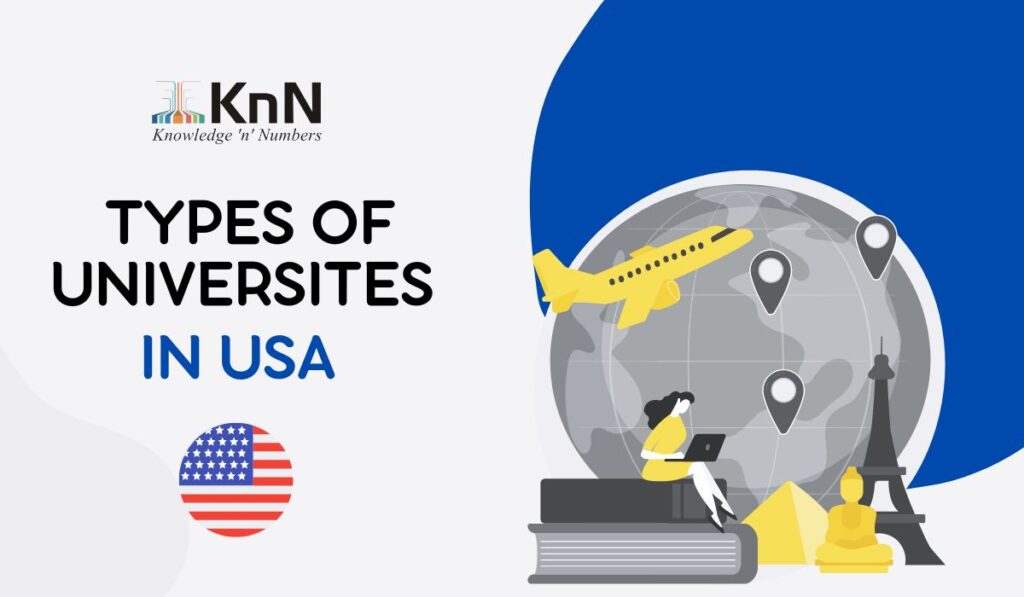Are you enrolling yourself in universities? Are you confused and overwhelmed with the amount of information available on the internet? Worry not, we are here to help you out of this situation. So let’s not waste any more time and get to know about the different types of universities and colleges in the United States of America.
The United States of America is a huge country, and just like the country, many universities are filled in it. There are government-owned universities and then there are private universities and research universities and many more. But how exactly are they different from each other and which type of college exactly suits your best interests? All these questions are in one article so let’s start reading.
Both universities and colleges are different in the USA and are categorized differently.
Types of Universities in the USA:
- Public universities: As the name suggests, public universities are funded by public means, meaning they are often bigger when compared to private universities and have less tuition fees. Accordingly, these types of universities have more number of students for local as well as commuter students.
- Private universities: Private universities enroll a sizable portion of students and receive no governmental funding. These colleges do, however, typically charge greater tuition than public universities because they don’t receive funding from the taxpayers but rather rely mostly on contributions, endowments, and tuition itself.
Private Universities in the USA:
- For-profit private universities: Private for-profit institutions of higher learning differ from non-profit ones in that their primary goal is to make money for their stockholders rather than only teaching students. This doesn’t necessarily imply that these institutions don’t provide high-quality education, either. There are lots of private, for-profit institutions with excellent curriculums.
- For non-profit private universities: Non-profit private universities’ principal goal is to provide top-notch education, not to be the most lucrative organization. Due to their greater dedication to developing high-quality curricula and instruction, these institutions typically have a better reputation than for-profit ones.
- Research universities: Research universities are considered to be doctorate-granting institutions that spend millions on research and have substantial research activity. They might be public or non-profit private universities.
There are 131 such schools in the United States, including numerous public universities, all eight Ivy League universities, and other prestigious universities.
Ivy League schools: Ivy Leagues are 8 Northeastern US-based universities and is also an American collegiate athletic conference. However, these universities not only have a huge competition and selection process but also offer a varied amount of programs from research to athletics.
The 8 of these universities are as follows:
- Harvard University
- Princeton University
- Dartmouth University
- Cornell University
- University of Pennsylvania
- Colombia University
- Yale University
Types of colleges in the USA: Colleges, unlike universities, take less time to graduate and give early access to start earning money or look for higher education however that doesn’t mean there are no programs that are longer to complete.
- Liberal Arts colleges: The majority of liberal arts colleges are non-profit private institutions (although there are a few tiny public liberal arts colleges as well), and they include courses in the humanities, sciences, and social sciences. In general, they tend to place less of an emphasis on athletics and more of an emphasis on undergraduate education and well-rounded education.Instead of splitting a degree into several branches, these universities often offer one broad subject of study. Instead of emphasizing technical abilities, they frequently concentrate on the more academic part of higher education.
- Community colleges: Community colleges, often known as junior colleges, are predominantly two-year institutes of higher learning. They offer lower-level tertiary education and award certificates, associate degrees, and diplomas. These schools typically draw students from the area and receive funding from local taxes.A lot of students choose community college as a stepping stone to a liberal arts or four-year university. Although community colleges are referred to as junior colleges, junior colleges are private two-year institutions, while community colleges are public two-year institutions.
- Other colleges: There are religious colleges, same-sex colleges, specialized institutions, art colleges, and for-profit universities in addition to liberal arts colleges and community colleges. These colleges may be public or private, and their operations are frequently quite similar to those of community colleges. However, each institution has its own set of regulations.
There are several colleges and universities and each with a special benefit and a program that suits the one that you truly want to learn and make a career out of. While there are plenty of options out there but what matters the most is what you want to study, and the amount of financial support or aid you can get while applying to a program.
But, the main thing is to do better in school before applying to colleges so that you don’t get stuck or waitlisted at your favorite universities. Hope this helped you and gave you a good understanding of the different types of colleges and universities present in the United States of America.







